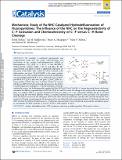Files in this item
Mechanistic study of Ru-NHC-catalyzed hydrodefluorination of fluoropyridines : the influence of the NHC on the regioselectivity of C–F activation and chemoselectivity of C–F versus C–H bond cleavage
Item metadata
| dc.contributor.author | McKay, David | |
| dc.contributor.author | Riddlestone, Ian M. | |
| dc.contributor.author | Macgregor, Stuart A. | |
| dc.contributor.author | Mahon, Mary F. | |
| dc.contributor.author | Whittlesey, Michael K. | |
| dc.date.accessioned | 2015-09-03T11:40:04Z | |
| dc.date.available | 2015-09-03T11:40:04Z | |
| dc.date.issued | 2015-02-06 | |
| dc.identifier | 174046661 | |
| dc.identifier | df11049a-9a2e-4f90-9f4b-05d22a94d823 | |
| dc.identifier | 84922776832 | |
| dc.identifier.citation | McKay , D , Riddlestone , I M , Macgregor , S A , Mahon , M F & Whittlesey , M K 2015 , ' Mechanistic study of Ru-NHC-catalyzed hydrodefluorination of fluoropyridines : the influence of the NHC on the regioselectivity of C–F activation and chemoselectivity of C–F versus C–H bond cleavage ' , ACS Catalysis , vol. 5 , no. 2 , pp. 776-787 . https://doi.org/10.1021/cs501644r | en |
| dc.identifier.issn | 2155-5435 | |
| dc.identifier.other | RIS: urn:BF72CD1BF7F306B7200162AAC4EFD2A8 | |
| dc.identifier.other | ORCID: /0000-0003-0362-7848/work/29608116 | |
| dc.identifier.uri | https://hdl.handle.net/10023/7398 | |
| dc.description | We acknowledge financial support from the EPSRC through grant numbers EP/J010677/1 (D.M.) and EP/J009962/1 (I.M.R.). | en |
| dc.description.abstract | We describe a combined experimental and computational study into the scope, regioselectivity, and mechanism of the catalytic hydrodefluorination (HDF) of fluoropyridines, C5F5?xHxN (x = 0?2), at two Ru(NHC)(PPh3)2(CO)H2 catalysts (NHC = IPr, 1, and IMes, 2). The regioselectivity and extent of HDF is significantly dependent on the nature of the NHC: with 1 HDF of C5F5N is favored at the ortho-position and gives 2,3,4,5-C5F4HN as the major product. This reacts on to 3,4,5-C5F3H2N and 2,3,5-C5F3H2N, and the latter can also undergo further HDF to 3,5-C5F2H3N and 2,5-C5F2H3N. para-HDF of C5F5N is also seen and gives 2,3,5,6-C5F4HN as a minor product, which is then inert to further reaction. In contrast, with 2, para-HDF of C5F5N is preferred, and moreover, the 2,3,5,6-C5F4HN regioisomer undergoes C?H bond activation to form the catalytically inactive 16e Ru-fluoropyridyl complex Ru(IMes)(PPh3)(CO)(4-C5F4N)H, 3. Density functional theory calculations rationalize the different regioselectivity of HDF of C5F5N at 1 and 2 in terms of a change in the pathway that is operating with these two catalysts. With 1, a stepwise mechanism is favored in which a N ? Ru σ-interaction stabilizes the key C?F bond cleavage along the ortho-HDF pathway. With 2, a concerted pathway favoring para-HDF is more accessible. The calculations show the barriers increase for the subsequent HDF of the lower fluorinated substrates, and they also correctly identify the most reactive C?F bonds. A mechanism for the formation of 3 is also defined, but the competition between C?H bond activation and HDF of 2,3,5,6-C5F4HN at 2 (which favors C?H activation experimentally) is not reproduced. In general, the calculations appear to overestimate the HDF reactivity of 2,3,5,6-C5F4HN at both catalysts 1 and 2. | |
| dc.format.extent | 12 | |
| dc.format.extent | 2770909 | |
| dc.language.iso | eng | |
| dc.relation.ispartof | ACS Catalysis | en |
| dc.subject | Catalysis | en |
| dc.subject | Hydrodefluorination | en |
| dc.subject | DFT | en |
| dc.subject | Mechanism | en |
| dc.subject | Ruthenium | en |
| dc.subject | Pentafluoropyidine | en |
| dc.subject | N-Heterocyclic carbenes | en |
| dc.subject | QD Chemistry | en |
| dc.subject | DAS | en |
| dc.subject.lcc | QD | en |
| dc.title | Mechanistic study of Ru-NHC-catalyzed hydrodefluorination of fluoropyridines : the influence of the NHC on the regioselectivity of C–F activation and chemoselectivity of C–F versus C–H bond cleavage | en |
| dc.type | Journal article | en |
| dc.contributor.institution | University of St Andrews. School of Chemistry | en |
| dc.identifier.doi | 10.1021/cs501644r | |
| dc.description.status | Peer reviewed | en |
This item appears in the following Collection(s)
Items in the St Andrews Research Repository are protected by copyright, with all rights reserved, unless otherwise indicated.

